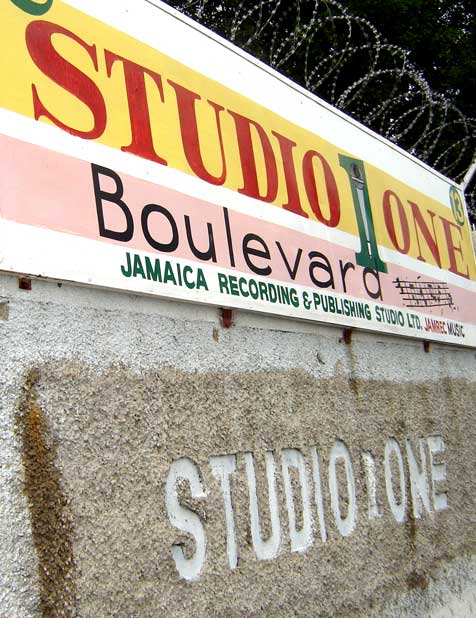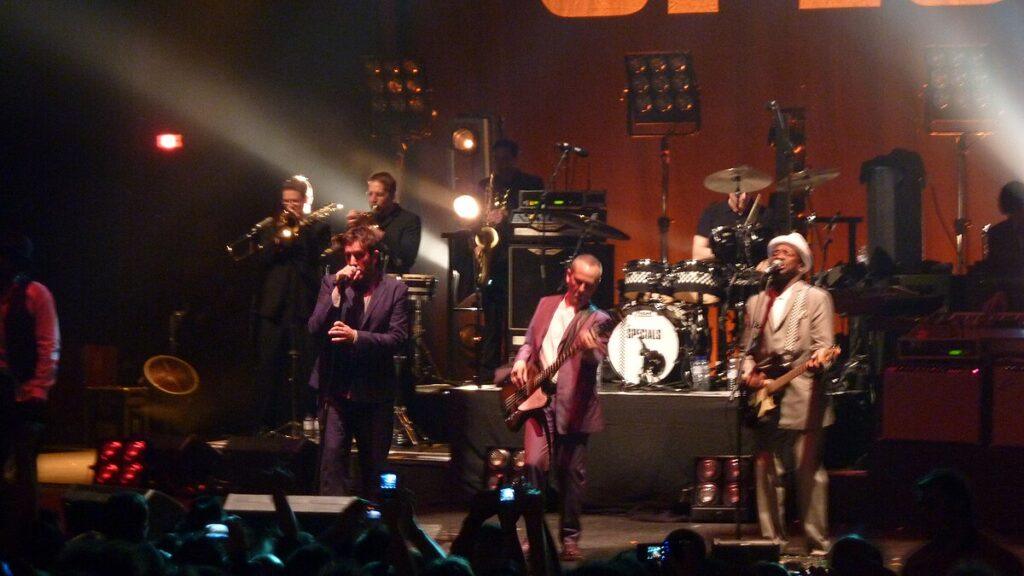Ska was not an overnight sensation; it emerged in the late 1950s and early 1960s, coming to life in the vibrant streets of Kingston, Jamaica as the Caribbean Island nation was earning its independence from Britain. In the sweltering heat and the rhythm of island life, a new sound was being born. Here, I talk a little about the history of ska music.

Jamaican musicians who had been raised on Jamaica’s original music known as mento along with the Trinidadian import calypso, plus American jazz and R&B began experimenting with new rhythmic approaches to musical performances. This manifested itself as the first wave of ska, giving us the first ska bands such as Toots & the Maytals, Desmond Dekker and the Israelites, Byron Lee & the Dragonaires, and the Skatalites. Jamaican Ska DJs and producers include the likes of Prince Buster, Duke Reid, and Clement “Coxsone” Dodd.
One supposes that something like Ska was inevitable given all the influences at play in Jamaica at that time. Its African, European, and indigenous influences created a melting pot from which ska arose.
Ska’s Relatively Painless Birth
But what exactly led to Ska’s birth? It’s likely a conflux of events and innovations. With the advent of sound systems – large public discos where DJs played music – ska found a medium to reach the masses. These gatherings became not only a musical hub but a throbbing social and cultural scene.

Understanding ska also involves recognizing Jamaica’s climate during those years of change. The country was on the cusp of independence from colonial rule, and its people were keen to express their identity. One way was through a sound that encapsulated their spirit and hopes for the future – ska. It was more than just music; it was a feeling, an attitude, an expression of freedom and celebration.
I’ve listed a few, but let’s look a little more closely at the trailblazers of this unique genre. These are the individuals and groups whose beats laid the foundation for what was and continues to be a global sensation.
Pioneers and Early Influencers of Ska
When exploring ska music, it’s vital to acknowledge the artists who laid the groundwork for the genre’s unmistakable rhythm and vibe. These musicians birthed a new sound that resonated deeply with the Jamaican populace – doing exactly what was required of it. Chief among these trailblazers were The Skatalites, a band whose contributions remain a blueprint for ska musicians to this day.
Then there were characters like Laurel Aitken, and rivals Prince Buster, and Derrick Morgan; not just performers, more like architects of a cultural phenomenon. Their music narrated the lives of Jamaicans in the 1960s – a discourse of resilience amid economic hardship and political change. Their charismatic stage presence and lyrical prowess captured the hearts of many and secured their status as legends.
This era encapsulates a period of prolific creativity and musical innovation. Recording studios like Studio One spearheaded by Clement ‘Coxsone’ Dodd, and Treasure Isle by Duke Reid, were not merely production houses but crucibles where the raw energy of ska was honed and showcased to an eager audience that spread beyond Jamaica’s shores.

The role of sound systems – portable DJ setups that blared music for communal street parties – cannot be understated. These events were incubators for ska’s growth, allowing songs to reverberate through neighbourhoods and etch themselves into the collective memory.
As befits the flux of its host, ska was not static; it reflected the dynamic spirit of its people. Its evolution became a narrative of Jamaica’s own transformations, setting the stage for the second wave or ‘Two Tone’ movement in the UK, which married ska with elements of punk rock and new wave. As the genre crossed borders, it carried with it the soul of its birthplace and a readiness to mingle with various musical styles.
Ska’s Evolution: Jamaica to the World
Ska music, born in Jamaica in the late 1950s, didn’t stay confined to its island origins for long. It travelled with the movements of people and the export of culture, changing and adapting with each new audience it found, especially in Britain. The transition of ska is a telling portrait of Jamaica’s social and cultural shifts as the island navigated post-independence.
Strangely, given Jamaica’s colonial history, and desire to escape colonial rule, Jamaicans were moving to Britain at around the time of Jamaica’s independence. It is down to several factors – social, economic, and political. Prime amongst them were the socio-economic challenges the country faced.

So, Jamaicans came to post-WWII Britain seeking economic opportunities as the victorious, but broke former colonial power was suffering a labour shortage. The British government actively encouraged immigration from the former Empire including Jamaica. The prospect of employment and higher wages in the United Kingdom was a big carrot.
Then there were colonial ties. This is perhaps the most paradoxical. Despite her independence, Jamaica maintained close ties with Britain, and Jamaicans retained Commonwealth citizenship. This made it easier to migrate to the UK compared to other non-Commonwealth countries, especially given that this was before the European Economic Community.
Furthermore, Jamaica faced social and political challenges for which independence from Britain alone was not the solution. Issues such as unemployment, poverty, and political unrest all prompted Jamaicans to seek a fresh start in Britain, hoping for a more stable and prosperous life.
Finally, access to education and healthcare in the UK was often perceived as better than in Jamaica. Many Jamaicans saw an opportunity to improve their quality of life and that of their families by moving to a country with more developed infrastructure, social services, and health care system.
It was not all sweetness and light though as Jamaicans who migrated encountered racial discrimination and prejudice. Despite the demand for labour, immigrants were faced with a whole range of social challenges, such as racism and cultural differences.
That said, the movement of Jamaicans to Britain contributed to the cultural diversity of Britain and played a role in shaping the social fabric of the country. One such area was the British music scene as ska found a receptive audience in Britain, particularly among Mods and later skinheads, who were drawn to the rhythm and style of the music, as well as the fashion associated with it. British working-class youths adopted ska, and it became a symbol of a subculture; it resonated with themes of unity and inclusion, appealing across racial lines during a time of social tension.
The influence of ska went further than the UK, stirring up music scenes across the world and giving rise to different subgenres. This durable music form left its mark on genres to come, like punk and new wave, with its upbeat tempos and unique offbeat rhythms. Around the world, local bands began fusing their own traditions with ska, creating rich new sounds.
Yet, even as ska music continued to morph and influence global music tendencies, back in Jamaica the genre faced a decline as rocksteady and reggae took the spotlight. These new genres slowed down the ska tempo, added new musical elements, and often carried heavier political messages. However, ska’s energetic spirit lived on, a testament to its enduring qualities.
In Jamaica, ska sometimes does get overshadowed by reggae. Nevertheless, it remains an integral part of the country’s cultural heritage, celebrated occasionally in festivals and honoured by music historians. This story of ska, from its local beginnings to international recognition, raises a compelling question: Is ska simply a music historical footnote, or does it continue as a legacy shaping contemporary sounds?
The Ska Revival in the United Kingdom: A Lasting Legacy
We have discussed how Jamaicans travelled to Britain and helped to bring about cultural metamorphosis there. One strand of which was the ska music which travelled with them. In the late 1970s and early 1980s, Britain experienced a cultural phenomenon as the children of those Jamaican importers of ska helped to rejuvenate and transform ska as it met with the punk and new wave movements.
Bands like The Specials, Madness, and The Selecter led what’s often called the ‘Two Tone’ movement. These groups fostered a sense of inclusivity and societal commentary in their music, resonating with the youth of the day.

The UK revival of ska went beyond mere musical innovation. It represented a blurring of racial lines at a time when tensions were high, with black and white musicians sharing stages and studio spaces. Their independent record label, 2 Tone Records, became synonymous with the genre’s resurgence, leaving an indelible mark on the music industry.
Despite the ebb and flow of its mainstream popularity, ska has never truly disappeared. The United Kingdom’s embrace of ska created ripples that continue to influence artists across genres. It serves as a testament to music’s ability to cross oceans and generations. What the UK scene proved is that ska is not just a chapter of music history, but an enduring legacy that shapes and is shaped by the cultural currents of the time.
In conclusion, ska is a genre imbued with rich layers of history, evolving as it has hopscotched around the globe. It is not just a relic of the past, but an active living genre, breathing new life into every scene it touches. As it continues to evolve and inspire, ska’s place in the music world holds fast, a vibrant reminder of its power to move, to integrate, and to endure.
